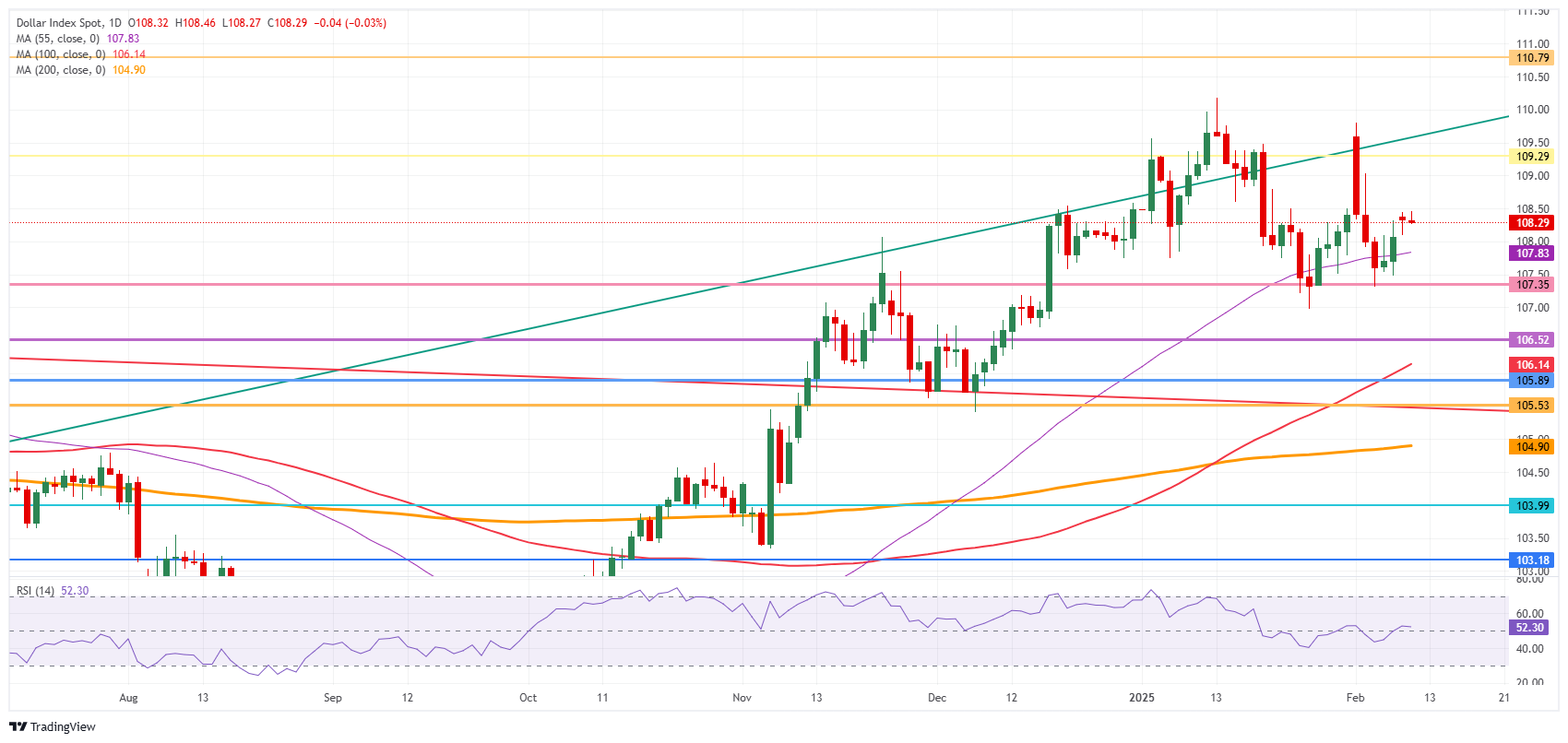- The US dollar quotes quite flat for the second consecutive day this week.
- All looks are put in the president of the Fed, Jerome Powell, addressing the Capitol.
- The dollar index (DXY) is quoting laterally above 108.00
The dollar index (DXY), which tracks the performance of the US dollar compared to six main currencies, is maintained in general plane and still resides above 108.00. The dollar seems to be immune to the tariff conversations of US President Donald Trump. While China silently imposed some tariffs minor to US products in a reprisal movement on Monday, Trump introduced a 15% tax on steel and aluminum for all importing countries that will enter into force on March 12.
This Tuesday’s economic calendar is dominated by the Federal Reserve (FED). In addition to the testimony of the president of the FED, Jerome Powell, before Congress, three Fed speakers are scheduled to make an appearance. The operators will want to hear if the Central Bank has plans to make changes in its monetary policy soon.
What moves the market today: a somnolence festival
- At 11:00 GMT, the National Federation of Independent Business (NFIB) has published its Business Optimism Index for January. The number was 102.8, below the estimate of 104.6 and compared to 105.1 in the December reading.
- The president of the FED, Jerome Powell, will maintain his semiannual testimony before the Congress at 15:00 GMT.
- More Fed speakers are scheduled to speak throughout the day:
- At 13:50 GMT, the president of the Bank of the Federal Reserve of Cleveland, Beth Hammack, will speak at the 2025 economic perspective conference at the center of the Central Bank.
- At 20:30 GMT, the governor of the Federal Reserve, Michelle Bowman, will speak at the management and policy conference of the Bank of the Iowa bankers in Des Moines.
- At 20:30 GMT, the president of the Bank of the Federal Reserve of New York, John Williams, will also offer a main speech at the Economic Summit and 2025 Perspectives of CBIA, organized by the Connecticut Business and Industry Association (CBIA) In Connecticut.
- The shares are fighting Tuesday with the trail hangover beginning to weigh on them. All the main European and American indices are red, although less than 0.5%.
- The CME Fedwatch tool projects a 93.5% probability that the Fed maintain interest rates without changes in its next meeting on March 19.
- The 10 -year performance of the US is quoting around 4.51%, rising again for the second consecutive day and recovering from its new annual minimum of 4.40% registered last week.
Technical analysis of the dollar index: Powell tail risk
The dollar index (DXY) is really becoming a drowsiness festival this week. There is no real movement in the dollar so far, despite many holders. Although US yields are the asset to monitor, with Powell’s testimony ahead, things could begin to move from now on.
Upwards, the first barrier in 109.30 (maximum of July 14, 2022 and a line of ascending trend) was briefly surpassed but did not remain last week. Once that level is recovered, the next level to be reached before progress remains more at 110.79 (maximum of September 7, 2022).
Downward, 107.35 (Maximum of October 3, 2023) continues to act as a strong support after several tests last week. In case it occurs lower, look for 106.52 (maximum of April 16, 2024), 106.14 (single mobile average of 100 days), or even 105.89 (resistance in June 2024) as better support levels.
Dollar index: daily graphic
US dollar FAQS
The US dollar (USD) is the official currency of the United States of America, and the “de facto” currency of a significant number of other countries where it is in circulation along with local tickets. According to data from 2022, it is the most negotiated currency in the world, with more than 88% of all global currency change operations, which is equivalent to an average of 6.6 billion dollars in daily transactions. After World War II, the USD took over the pound sterling as a world reserve currency.
The most important individual factor that influences the value of the US dollar is monetary policy, which is determined by the Federal Reserve (FED). The Fed has two mandates: to achieve price stability (control inflation) and promote full employment. Its main tool to achieve these two objectives is to adjust interest rates. When prices rise too quickly and inflation exceeds the 2% objective set by the Fed, it rises the types, which favors the price of the dollar. When inflation falls below 2% or the unemployment rate is too high, the Fed can lower interest rates, which weighs on the dollar.
In extreme situations, the Federal Reserve can also print more dollars and promulgate quantitative flexibility (QE). The QE is the process by which the Fed substantially increases the flow of credit in a stuck financial system. It is an unconventional policy measure that is used when the credit has been exhausted because banks do not lend each other (for fear of the default of the counterparts). It is the last resort when it is unlikely that a simple decrease in interest rates will achieve the necessary result. It was the weapon chosen by the Fed to combat the contraction of the credit that occurred during the great financial crisis of 2008. It is that the Fed prints more dollars and uses them to buy bonds of the US government, mainly of financial institutions. Which usually leads to a weakening of the US dollar.
The quantitative hardening (QT) is the reverse process for which the Federal Reserve stops buying bonds from financial institutions and does not reinvote the capital of the wallet values that overcome in new purchases. It is usually positive for the US dollar.
Source: Fx Street
I am Joshua Winder, a senior-level journalist and editor at World Stock Market. I specialize in covering news related to the stock market and economic trends. With more than 8 years of experience in this field, I have become an expert in financial reporting.






